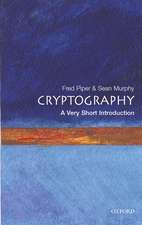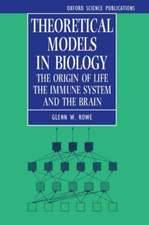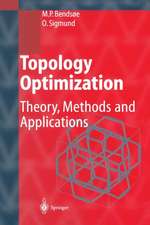Teaching Mathematical Modelling: Connecting to Research and Practice: International Perspectives on the Teaching and Learning of Mathematical Modelling
Editat de Gloria Ann Stillman, Gabriele Kaiser, Werner Blum, Jill P. Brownen Limba Engleză Hardback – 6 noi 2013
| Toate formatele și edițiile | Preț | Express |
|---|---|---|
| Paperback (1) | 960.93 lei 6-8 săpt. | |
| SPRINGER NETHERLANDS – 18 sep 2016 | 960.93 lei 6-8 săpt. | |
| Hardback (1) | 967.22 lei 6-8 săpt. | |
| SPRINGER NETHERLANDS – 6 noi 2013 | 967.22 lei 6-8 săpt. |
Preț: 967.22 lei
Preț vechi: 1179.53 lei
-18% Nou
Puncte Express: 1451
Preț estimativ în valută:
185.07€ • 193.75$ • 153.14£
185.07€ • 193.75$ • 153.14£
Carte tipărită la comandă
Livrare economică 05-19 aprilie
Preluare comenzi: 021 569.72.76
Specificații
ISBN-13: 9789400765399
ISBN-10: 9400765398
Pagini: 495
Ilustrații: XVI, 627 p. 193 illus., 59 illus. in color.
Dimensiuni: 155 x 235 x 43 mm
Greutate: 1.07 kg
Ediția:2013
Editura: SPRINGER NETHERLANDS
Colecția Springer
Seria International Perspectives on the Teaching and Learning of Mathematical Modelling
Locul publicării:Dordrecht, Netherlands
ISBN-10: 9400765398
Pagini: 495
Ilustrații: XVI, 627 p. 193 illus., 59 illus. in color.
Dimensiuni: 155 x 235 x 43 mm
Greutate: 1.07 kg
Ediția:2013
Editura: SPRINGER NETHERLANDS
Colecția Springer
Seria International Perspectives on the Teaching and Learning of Mathematical Modelling
Locul publicării:Dordrecht, Netherlands
Public țintă
ResearchCuprins
Series Preface: Gabriele Kaiser and Gloria Stillman.- Chapter 1 Mathematical Modelling: Connecting to Teaching and Research Practices – the impact of globalisation: Gloria Stillman, Gabriele Kaiser, Werner Blum, and Jill Brown.- Part I Innovative Practices in Modelling Education Research and Teaching.- Chapter 2 From Conference to Community: An ICTMA Journey—The Ken Houston Inaugural Lecture: Peter Galbraith.- Chapter 3 Modelling from the Perspective of Commognition – An Emerging Framework: Jonas Bergman Ärlebäck and Peter Frejd.- Chapter 4 Should Interpretation Systems be Considered to be Models if They only Function Implicitly?: Rita Borromeo Ferri and Richard Lesh.- Chapter 5 Mathematical Modelling, Mathematical Content and Tensions in Discourses: Andréia Maria Pereira de Oliveira and Jonei Cerqueira Barbosa.- Chapter 6 Ethnomodelling as a Methodology for Ethnomathematics: Milton Rosa and Daniel Clark Orey.- Chapter 7 Dual Modelling Cycle Framework for Responding to the Diversities of Modellers: Akihiko Saeki and Akio Matsuzaki.- Chapter 8 The Eyes to See: Theoretical Lenses for Mathematical Modelling Research: Nils Buchholtz.- Chapter 9 Strässer’s Didactic Tetrahedron as a Basis for Theorising Mathematical Modelling Activity within Social Contexts: Vince Geiger.- Chapter 10 Ethnomodelling as a Research Lens on Ethnomathematics and Modelling: Milton Rosa and Daniel Clark Orey.- Part II Research into, or Evaluation of, Teaching Practice.- Chapter 11 Real-life Modelling within a Traditional Curriculum: Lessons from a Singapore Experience: Ang KengCheng.- Chapter 12 Students’ Mathematical Learning in Modelling Activities: Morten Blomhøj and Tinne Hoff Kjeldsen.- Chapter 13 Students' Designing an Ideal Tourism Route as Mathematical Modelling: Chan Chun Ming Eric.- Chapter 14 Comparison of Mathematical Modelling Skills of Secondary and Tertiary Students: Juntao Fu and Jinxing Xie.- Chapter 15 Taking Advantage of Incidental School Events to Engage with the Applications of Mathematics: The Case of Surviving the Reconstruction: Vince Geiger, Merrilyn Goos, and Shelley Dole.- Chapter 16 The Development of Modelling Competencies by Year 9 Students: Effects of a Modelling Project: Susanne Grünewald.- Chapter 17 Evidence of a Dual Modelling Cycle: Through a Teaching Practice Example for Pre-service Teachers: Akio Matsuzaki and Akihiko Saeki.- Chapter 18 Considering Multiple Solutions for Modelling Problems – Design and First Results from the MultiMa-Project: Stanislaw Schukajlow and André Krug.- Chapter 19 Challenges in Modelling Challenges: Intents and Purposes: Gloria Stillman, Jill Brown, and Peter Galbraith.- Chapter 20 Mathematical Modelling of a Real-world Problem: The Decreasing Number of Bluefin Tuna: Akira Yanagimoto and Noboru Yoshimura.- Chapter 21 Mathematical Modelling of a Social Problem: Pension Tax Issues: Noboru Yoshimura and Akira Yanagimoto.- Part III Pedagogical Issues for Teaching and Learning.- Chapter 22 Pedagogical Reflections on the Role of Modelling in Mathematics Instruction: Toshikazu Ikeda.- Chapter 23Complex Modelling Problems in Co-Operative, Self-directed Learning Environments: Gabriele Kaiser and Peter Stender.- Chapter 24 Inducting Year 6 Students into “a Culture of Mathematising as a Practice”: Jill Brown.- Chapter 25 A Whole Week of Modelling – Examples and Experiences of Modelling for Students in Mathematics Education: Nils Buchholtz and Sarah Mesrogli.- Chapter 26 Teachers’ Self-Perceptions of their Pedagogical Content Knowledge Related to Modelling – An Empirical Study with Austrian Teachers: Sebastian Kuntze, Hans-Stefan Siller, and Christiane Vogl.- Chapter 27 A Cross-Sectional Study about Modelling Competency in Secondary School: Matthias Ludwig and Xenia-Rosemarie Reit.- Chapter 28 Teacher Readiness in Mathematical Modelling: Are there Differences between Pre-service and In-service Teachers? Kit Ee Dawn Ng.- Chapter 29 Exploring the Relationship between Mathematical Modelling and Classroom Discourse: Trevor Redmond, Raymond Brown, and Joanne Sheehy.- Chapter 30 The Role of Textbooks in Developing a Socio-critical Perspective on Mathematical Modelling in Secondary Classrooms: Gloria Stillman, Jill P Brown, Rhonda Faragher, Vince Geiger and Peter Galbraith.- Chapter 31 Pre-service Secondary School Teachers’ Knowledge in Mathematical Modelling – A Case Study: Tan Liang Soon and Ang Keng Cheng.- Chapter 32 How Students Connect Descriptions of Real-world Situations to Mathematical Models in Different Representational Modes: Wim Van Dooren, Dirk De Bock, and Lieven Verschaffel.- Chapter 33 Pre-service Teacher Learning for Mathematical Modelling: Mark Winter.- Chapter 34 Initial Perspectives of Teacher Professional Development onMathematical Modelling in Singapore: Problem Posing and Task Design: Lee Ngan Hoe.- Chapter 35 Initial Perspectives of Teacher Professional Development on Mathematical Modelling in Singapore: Conceptions of Mathematical Modelling: Chan Chun Ming Eric.- Chapter 36 Initial Perspectives of Teacher Professional Development on Mathematical Modelling in Singapore: A Framework for Facilitation: Kit Ee Dawn Ng.- Chapter 37 Teacher Professional Development on Mathematical Modelling: Initial Perspectives from Singapore: Vince Geiger.- Part IV Influences of Technologies.- Chapter 38 Reality Based Test Tasks with Digital Tools at Lower Secondary: Gilbert Greefrath and Michael Rieß.- Chapter 39 On Comparing Mathematical Models and Pedagogical Learning: Janeen Lamb and Jana Visnovska .- Part V Assessment in Schools.- Chapter 40 Formative Assessment in Everyday Teaching of Mathematical Modelling: Implementation of Written and Oral Feedback to Competency-Oriented Tasks: Michael Besser, Werner Blum, and Malte Klimczak.- Chapter 41 Assessment of Modelling in Mathematics Examination Papers: Ready-made Models and Reproductive Mathematising: Pauline Vos.-Part VI Applicability at Different Levels of Schooling, Vocational Education, and in Tertiary Education.- Chapter 42 Complex Modelling in the Primary and Middle School Years: An Interdisciplinary Approach: Lyn D. English.- Chapter 43 Modelling in Brazilian Mathematics Teacher Education Courses: Maria Salett Biembengut.- Chapter 44 TheDevelopment of Mathematical Concept Knowledge and of the Ability to use this Concept to Create a Model: César Cristóbal Escalante and Verónica Vargas Alejo.- Chapter 4 Problem Posing: A Possible Pathway to Mathematical Modelling: Ann Downton.- Chapter 46 A Study of the Effectiveness of Mathematical Modelling of Home: Delivery Packaging on Year 12 Students' Function Education: Tetsushi Kawasaki and Yoshiki Nisawa.- Chapter 47 How to Introduce Mathematical Modelling in Industrial Design Education? Geert Langereis, Jun Hu, and Loe Feijs.- Chapter 48 Rationality of Practice and Mathematical Modelling – On Connections, Conflicts, and Codifications: Lars Mouwitz.- Chapter 49 Extending Model Eliciting Activities (MEAs) beyond Mathematics Curricula in Universities: Mark Schofield.- Chapter 50 Building Awareness of Mathematical Modelling in Teacher Education: A Case Study in Indonesia: Wanty Widjaja.- Part VII Modelling and Applications in Business and the Lived Environment.- Chapter 51: Mathematics and the Pharmacokinetics of Alcohol: Michael Jennings and Peter Adams. - Chapter 52 Beyond the Modelling Process: An Example to Study the Logistic Model of Customer Lifetime Value in Business Marketing: Issic K. C. Leung.- List of Corresponding Authors.- Refereeing Process.- Index
Recenzii
From the reviews:
“Teaching Mathematical Modelling: Connecting to Research and Practice is a vast collection of international research on teaching mathematical modeling of applied problems. The book explores both pedagogical and teaching practices for the interested reader. The students’ ages range from elementary to secondary schooling years, with a heavy focus on how teachers can use real-world examples in their mathematics classes.” (Peter Olszewski, MAA Reviews, May, 2014)
“Teaching Mathematical Modelling: Connecting to Research and Practice is a vast collection of international research on teaching mathematical modeling of applied problems. The book explores both pedagogical and teaching practices for the interested reader. The students’ ages range from elementary to secondary schooling years, with a heavy focus on how teachers can use real-world examples in their mathematics classes.” (Peter Olszewski, MAA Reviews, May, 2014)
Caracteristici
Presents examples of modeling and application in business, the environment, industry and everyday practices Presents a broad range of international perspectives on modelling Explores the utility of emerging research perspectives?























